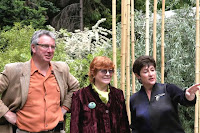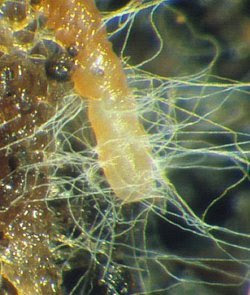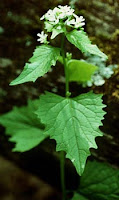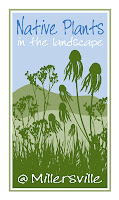Photo: Vincent Laforet for The New York Times
Saturday, June 28, 2008
New York City waterfalls: "remnants of a primordial Eden"
Photo: Vincent Laforet for The New York Times
Thursday, June 26, 2008
High Line News
Designs for the first phase of the High Line, a new urban park in Manhattan built on an old elevated freight rail viaduct, were announced today (see previous post).
Here is a link to the latest New York Times article. Though Piet Oudolf isn't mentioned, he is responsible for planting designs in (on?) the new park. If you know his plantings in Battery Park around the southern tip of Manhattan, you can see a resemblance between his containerized plantings at Battery Park and the plantings designed for the High Line. Both are essentially plants in containers - very large containers to be sure.
The New York Times also provides a brief slide show of the first phase design.
Photo: Design by Field Operations and Diller Scofidio + Renfro. Courtesy of City of New York.
Tuesday, June 24, 2008
Gardens in Argentina and Chile
 We're planning a visit to Argentina (Buenos Aires with side trips) and Chile (Santiago with shorter side trips) in February 2009. I haven't been able to find a good source listing gardens and natural areas of particular interest to gardeners. The standard guidebooks are of little use. If you have recommendations or know of such information, I'd appreciate your help.
We're planning a visit to Argentina (Buenos Aires with side trips) and Chile (Santiago with shorter side trips) in February 2009. I haven't been able to find a good source listing gardens and natural areas of particular interest to gardeners. The standard guidebooks are of little use. If you have recommendations or know of such information, I'd appreciate your help.rosemontgolden[at]gmail[dot]com
Labels:
Argentina,
Buenos Aires,
Chile,
gardens,
Santiago
Saturday, June 21, 2008
Teasel: Dipsacus fullonum
Teasel apparently was imported into the U.S. in the early to mid-19th century for use in wool processing. Here is an informative link.
 To my eye, teasel looks best used as an occasional accent. Large stands lose something because the plant's unique, upward-reaching structure and reflective qualities are lost when too many compete for attention. They also become rather scraggly by fall, so I recommend cutting them to the ground before seeds mature. (Use gloves; they are covered with sharp prickels.) You can save one or two seed heads for limited planting.
To my eye, teasel looks best used as an occasional accent. Large stands lose something because the plant's unique, upward-reaching structure and reflective qualities are lost when too many compete for attention. They also become rather scraggly by fall, so I recommend cutting them to the ground before seeds mature. (Use gloves; they are covered with sharp prickels.) You can save one or two seed heads for limited planting.Teasel is a biennial, so in the first year you will see only low rosettes with prickly leaves, then in the second year they soar to six or seven feet. The plant dies after making seed, so you will need to sow seed every year to assure a continuing presence in the garden.
If you are not sure you can be vigilant, do not plant teasel.
Wednesday, June 18, 2008
Iris versicolor: a plant for wet clay and sun
Tuesday, June 17, 2008
Garden Diary: Lines and perspective
So - what do I do with this "feature"? As soon as I have the financial means, I'd like to hire an arborist to remove the dead lower branches of the cedars, leaving simple, clean verticals topped by evergreen clouds of foliage. I've seen this treatment of cedars at William Faulkner's house in Oxford, Mississippi (see photo below). Once that's done, the area calls out for some focal object, perhaps sculptural, but certainly affordable.
The intervening area is probably the wettest in the garden. While I would like to use structural hedging to order the space and contrast with the wilder plantings, I haven't found appropriate shrubs for such wet conditions. Gardening in this place certainly does impose severe constraints. Some kind of physical structure may be the answer.
I have to remember this is a wet prairie (though an artificial one) and I can't stray too far from that concept.
Saturday, June 14, 2008
Another take on Chelsea: Thinkingardens
 For a more iconoclastic take on the Chelsea Flower Show, I recommend you go to the Thinkingardens website. Stephen Anderton, Anne Wareham, and Corrine Julius (l to r) comment on their picks of the show, and offer insightful commentary on the gardens. Their "Best in Show" is not the judges' pick. You will also find a Thinkingardens link to a Royal Horticultural Society video of the three discussing the gardens, along with written commentary. Explore the RHS site for other information such as plant lists for many of the gardens. Just don't try to play any of the BBC videos; they don't work if you live outside the UK.
For a more iconoclastic take on the Chelsea Flower Show, I recommend you go to the Thinkingardens website. Stephen Anderton, Anne Wareham, and Corrine Julius (l to r) comment on their picks of the show, and offer insightful commentary on the gardens. Their "Best in Show" is not the judges' pick. You will also find a Thinkingardens link to a Royal Horticultural Society video of the three discussing the gardens, along with written commentary. Explore the RHS site for other information such as plant lists for many of the gardens. Just don't try to play any of the BBC videos; they don't work if you live outside the UK.Germaine Greer also has an article on the 2007 Chelsea Flower Show posted on Thinkingardens. The Chelsea gardens are really exhibits, show gardens put together from plants grown for the most part, in highly artificial environments. They are in no respect real gardens, and Ms. Greer has had it with the artificiality of it all.
Thinkingardens is a website devoted to those who care about gardening and garden design as a serious endeavor - a concern rarely voiced in the U.S. and, from what I read there, not in the UK either.
(Photo: Charles Hawes from Thinkingardens website)
Wednesday, June 11, 2008
Delicate complexity of soil
 Over 75% of the plants living on the earth benefit from symbiotic relationships with small, microscopic fungi attached to their roots. The fungi are referred to as micorrhiza (my-core-i-zuh). Though we usually can't see them - they are under ground and are very small - their beneficial effects on plants are real and substantial. One major benefit is an increase in delivery of phosphorus to the root system.
Over 75% of the plants living on the earth benefit from symbiotic relationships with small, microscopic fungi attached to their roots. The fungi are referred to as micorrhiza (my-core-i-zuh). Though we usually can't see them - they are under ground and are very small - their beneficial effects on plants are real and substantial. One major benefit is an increase in delivery of phosphorus to the root system.One of the less well attended presentations at last week's Native Plants in the Landscape conference at Millersville University in Pennsylvania was "Micorrhizal Fungi: Hidden Friends of Plants." Dr. Roger Tai Koide of Pennsylvania State University described recent research that clearly demonstrates the benefit of such relationships to most plants.
The fungi grow very small, even microscopic, filaments - called hyphae (hi-fee) - that extend from the roots of plants into surrounding soil. These filaments, in effect, function as extensions of a plant's roots, and can effectively expand the root's surface area thousands of times. The photo above shows the white hyphae extending our from a root.
Does a gardener need to know about micorrhiza? Probably not, if you measure value only in direct utilitarian terms. But there is an important lesson to be learned from this bit of knowledge: our environment is extraordinarily complex and we can easily disrupt it if we blunder forward in ignorance, without considering what we do not know. There is a delicately balanced, invisible ecosystem underground that demands respect, perhaps even reverence.
 Actually, there is one practical application for this knowledge, and there are probably many more. The highly invasive plant, garlic mustard (Alliaria petiolata), damages micorrhiza. Why this is remains a mystery. In addition to its ability to completely overwhelm native plant communities and to form a virtual monoculture over the ground surface, at least in North America, it has insidious underground effects, damaging the symbiotic relationships that benefit many other plant species... yet another reason to support efforts to eradicate garlic mustard from our environment.
Actually, there is one practical application for this knowledge, and there are probably many more. The highly invasive plant, garlic mustard (Alliaria petiolata), damages micorrhiza. Why this is remains a mystery. In addition to its ability to completely overwhelm native plant communities and to form a virtual monoculture over the ground surface, at least in North America, it has insidious underground effects, damaging the symbiotic relationships that benefit many other plant species... yet another reason to support efforts to eradicate garlic mustard from our environment.There is another mystery too. In its native European habitats, garlic mustard does not have this effect!
Saturday, June 07, 2008
Native plants: gardening without guilt
 This is the first year I've come away from the Native Plants in the Landscape conference without feeling I am a total outsider, possibly even a spy, in a nest of native purists. (Just got back from the conference, held June 5 through 7 at Millersville University in Pennsylvania.) The native plant rattle in the American gardening community can be so extreme I hadn't realized before there are many, like me, who occupy a middle ground, even among conference attendees.
This is the first year I've come away from the Native Plants in the Landscape conference without feeling I am a total outsider, possibly even a spy, in a nest of native purists. (Just got back from the conference, held June 5 through 7 at Millersville University in Pennsylvania.) The native plant rattle in the American gardening community can be so extreme I hadn't realized before there are many, like me, who occupy a middle ground, even among conference attendees.C. Colston Burrell's opening presentation on the 20th Century Native Plant Movement in America was a refreshing, highly entertaining, and appropriately generalist take on this sometimes politically charged subject. Yes, native plants are important to maintaining local and regional ecosystems. No, we don't have to plant only natives so long as we are responsible and don't use species proven to be highly invasive and disruptive to the environment. Yes, aesthetics is a valid concern in gardening. After all, humans are part of the ecosystem too; we get to have a say. Yes, it's hard to define "native." But, no, the arrival of white Europeans on American shores isn't a good basis for a valid definition. Regional differences in plants, even plants of the same species, and local genetic provenance, are much more important.
This conference attracts numerous professional garden designers, experienced gardeners, and nursery men and women specializing in native plants, so the level of discourse tends to be quite high. I hope to report on one or two of the more specialized sessions I attended in another posting. I particularly enjoyed Don Knezick's "Genetic Integrity of Native Plants: Provenance is Forever" and Dr. Roger Tai Koide's "Mycorrhizal Fungi: Hidden Friends of Plants."
A highlight of this conference is the native plant sale, and it's one of the best. Nurseries from eastern Pennsylvania down into the Virginias offer perennials, shrubs and trees, many of which are rare in trade and difficult to find. I came back with four winterberry hollies (Ilex verticillata) - nothing rare in that selection but needed in my garden nevertheless, five Iris versicolor of sufficient size to divide into ten plants to join my late May/early June iris splash, two sizeable copper irises (Iris fulva) to go by the pond, two "Dolls eyes" baneberries (Actaea pachypoda) for the woodland garden, one Sagittaria latifolia to go into the pond, and ten Meehania cordata to try out as groundcover in the woodland. Okay, I confess, there's nothing particularly rare in my selections, but other offerings included Moosewood (Acer pennsylvanicum), various native gingers (formerly asarum, now hexastylis), all sorts of big leaf magnolias, Jeffersonia diphylla, and on and on.
If you live within driving distance of Millersville, consider the conference in 2009.
Monday, June 02, 2008
"English Gardens"
New Hope, Pennsylvania is just across the Delaware from my house ... in Bucks County (oft referred to as "Big Bucks" County). There is an annual garden tour, only one of which I've attended. There wasn't much to see. This year two "English gardens" are among those featured. I'm not sure what is meant by the term "English garden" in this context, but it may have something to do with an undefined yearning for something more than the typical American lawn with foundation plantings, or simply with pretension. I can imagine boxwoods and some elements of formality. If English gardens belong anywhere, they belong in England... and perhaps not even there.
Subscribe to:
Posts (Atom)